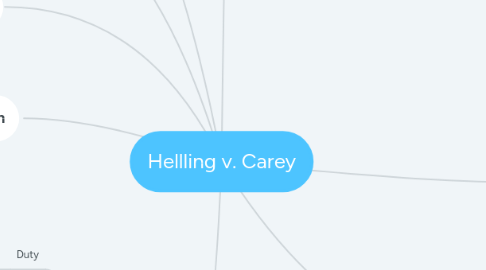
1. Application
1.1. Duty
1.1.1. Given the multiple visits to the ophthalmologists, there was a definite physician-patient relationship established
1.2. Breach of Duty
1.2.1. A reasonable ophthalmologist would have checked her eye pressure given her multiple visits
1.2.1.1. Plaintiff saw the defendants 10 times for eye complaints
1.2.2. Defendants argue that the standard of care is not to test for glaucoma under the age of 40
1.2.2.1. However, this is in the absence of any eye complaints.
1.2.3. Testing for the eye pressure is anoninvasive, harmless, and simple test
1.3. Damages
1.3.1. Patient suffered permanent loss of vision
1.4. Causation
2. Conclusion
2.1. The Supreme Court found in favor of the plaintiffs
2.1.1. A reasonable ophthalmologist would have tested for glaucoma given the multiple visits for the same complaint
3. Impact
3.1. Reasonable prudence
3.1.1. Standard of care must also include good judgment or common sense
3.2. Gates v. Jensen (1979)
3.2.1. Another missed cause of glaucoma
3.2.1.1. Physician must exercise reasonable and prudent care under the circumstances
3.3. Hall v. Hilbun (1985)
3.3.1. Plaintiff died after surgery for small bowel obstruction
3.3.1.1. Expert witnesses much be familiar with the local standard of care
4. Importance
4.1. Health care professionals have to do more than follow clinical guidelines. They must consider all possible diagnoses no matter how unlikely.
5. Influence
5.1. Due to vicarious liability, health care facilities must be aware of the standard of care and reasonable prudence.
5.2. Insurance companies much insure health care providers who are negligent despite following clinical guidelines
6. Facts
6.1. Parties
6.1.1. Plaintiffs
6.1.1.1. Barbara Helling
6.1.1.2. Morrison Helling
6.1.2. Defendants
6.1.2.1. Thomas Carey
6.1.2.1.1. Ophthalmologist
6.1.2.2. Robert Laughlin
6.1.2.2.1. Opthalamologist
6.2. What happened
6.2.1. Ms. Helling saw Dr. Carey and Dr. Laughlin for myopia in 1959
6.2.1.1. The doctors fitted her for contact lenses
6.2.2. Ms. Helling saw the doctors multiple times for "irritation" in her eyes
6.2.2.1. Two times in 1963
6.2.2.2. Three times in 1967
6.2.2.3. Five times in 1968
6.2.3. Dr. Carey finally tests Ms. Helling's eye pressure and field of vision in Oct 1968
6.2.3.1. Diagnosed with glaucoma at age 32
6.2.3.2. Lost peripheral completely and significant loss of central vision
6.3. Procedural history
6.3.1. In Aug 1969, Ms. Helling filed a complaint that her loss of vision was due to proximate results of the defendants' negligence
6.3.1.1. Trial court's judgment was in favor of the defendants
6.3.1.1.1. Washington Supreme Court reversed this decision
7. Issue
7.1. Are the defendants negligent by missing the defendant's glaucoma diagnosis?
8. Rule
8.1. Negligence
8.1.1. Duty of care
8.1.1.1. Did the plaintiff and defendants have a physician-patient relationship with a duty of care?
8.1.2. Breach of duty
8.1.2.1. Did the defendants not exercise the same degree of care that another reasonable ophthalmologist would have provided?
8.1.3. Damages
8.1.3.1. Did the plaintiff suffer physical damages while under the care of the defendants?
8.1.4. Causation
8.1.4.1. Was the breach of duty by the defendants the proximate cause of the damages?
